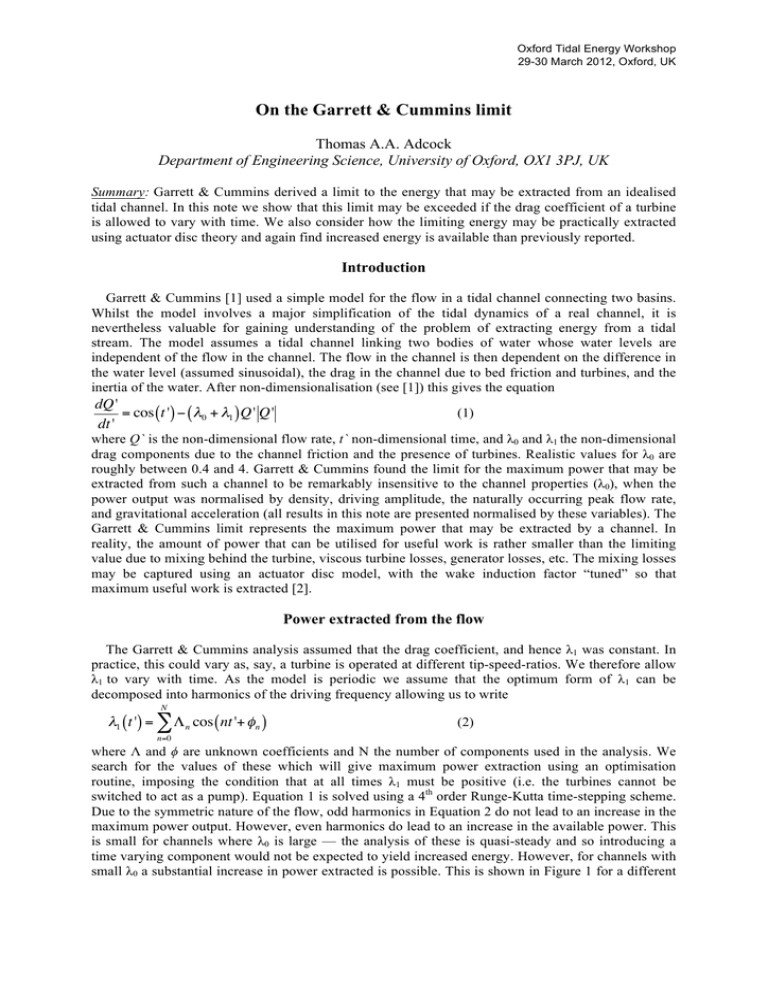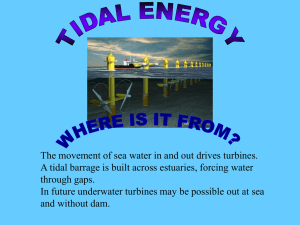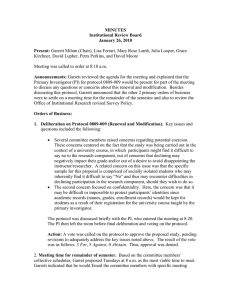∑ cos nt`+φn - University of Oxford
advertisement

Oxford Tidal Energy Workshop 29-30 March 2012, Oxford, UK On the Garrett & Cummins limit Thomas A.A. Adcock Department of Engineering Science, University of Oxford, OX1 3PJ, UK Summary: Garrett & Cummins derived a limit to the energy that may be extracted from an idealised tidal channel. In this note we show that this limit may be exceeded if the drag coefficient of a turbine is allowed to vary with time. We also consider how the limiting energy may be practically extracted using actuator disc theory and again find increased energy is available than previously reported. Introduction Garrett & Cummins [1] used a simple model for the flow in a tidal channel connecting two basins. Whilst the model involves a major simplification of the tidal dynamics of a real channel, it is nevertheless valuable for gaining understanding of the problem of extracting energy from a tidal stream. The model assumes a tidal channel linking two bodies of water whose water levels are independent of the flow in the channel. The flow in the channel is then dependent on the difference in the water level (assumed sinusoidal), the drag in the channel due to bed friction and turbines, and the inertia of the water. After non-dimensionalisation (see [1]) this gives the equation dQ' = cos (t ') − ( λ0 + λ1 ) Q' Q' dt ' (1) where Q` is the non-dimensional flow rate, t` non-dimensional time, and λ0 and λ1 the non-dimensional drag components due to the channel friction and the presence of turbines. Realistic values for λ0 are roughly between 0.4 and 4. Garrett & Cummins found the limit for the maximum power that may be extracted from such a channel to be remarkably insensitive to the channel properties (λ0), when the power output was normalised by density, driving amplitude, the naturally occurring peak flow rate, and gravitational acceleration (all results in this note are presented normalised by these variables). The Garrett & Cummins limit represents the maximum power that may be extracted by a channel. In reality, the amount of power that can be utilised for useful work is rather smaller than the limiting value due to mixing behind the turbine, viscous turbine losses, generator losses, etc. The mixing losses may be captured using an actuator disc model, with the wake induction factor “tuned” so that maximum useful work is extracted [2]. Power extracted from the flow The Garrett & Cummins analysis assumed that the drag coefficient, and hence λ1 was constant. In practice, this could vary as, say, a turbine is operated at different tip-speed-ratios. We therefore allow λ1 to vary with time. As the model is periodic we assume that the optimum form of λ1 can be decomposed into harmonics of the driving frequency allowing us to write N λ1 (t ') = ∑ Λ n cos ( nt '+ φn ) (2) n=0 where Λ and ϕ are unknown coefficients and N the number of components used in the analysis. We search for the values of these which will give maximum power extraction using an optimisation routine, imposing the condition that at all times λ1 must be positive (i.e. the turbines cannot be switched to act as a pump). Equation 1 is solved using a 4th order Runge-Kutta time-stepping scheme. Due to the symmetric nature of the flow, odd harmonics in Equation 2 do not lead to an increase in the maximum power output. However, even harmonics do lead to an increase in the available power. This is small for channels where λ0 is large — the analysis of these is quasi-steady and so introducing a time varying component would not be expected to yield increased energy. However, for channels with small λ0 a substantial increase in power extracted is possible. This is shown in Figure 1 for a different Oxford Tidal Energy Workshop 29-30 March 2012, Oxford, UK numbers of harmonics. It can be seen that the solution appears to be converging as more components are used. Normalised power 0.4 N=0 N=2 N=4 N=6 0.35 0.3 0.25 0.2 Limit derived by Garrett & Cummins 0 0.5 1 1.5 2 2.5 3 3.5 4 0 Figure 1 Energy that may be extracted from a channel with different numbers of components. Useful energy available An upper limit for the useful energy available may be derived by using an actuator disc model in the channel to calculate λ1 and the power output. To maximise power output, the wake induction factor of the turbines needs to be “tuned” [2]. In this analysis we use the turbine model of Garrett & Cummins [3]. Whilst this is valid only for small Froude number, for realistic channels we find negligibly different results when the finite Froude number model [4] is used. We assume the optimum wake induction factor has sinusoidal components in the same manner as Equation 2 and a routine is run to find these. We consider only one row of turbines — multiple rows may be accounted for by dividing λ0 by the number of rows. Figure 2 shows the available power for two different blockage ratios. N=0 corresponds to the analysis of Vennel (see his Fig. 7b). Conclusions We have shown that it is possible to extract more power from an idealised channel than the limit introduced by Garrett & Cummins and also that more of this may be utilised than given in the anlaysis by Vennel. References: [1] Garrett, C., Cummins, P. (2005). The power potential of tidal currents. Proc. R. Soc. A. 461 2563-2572 [2] Vennel, R. (2010) Tuning turbines in a tidal channel . J. Fluid Mech. 663, 253-267. [3] Garrett, C., Cummins, P. (2007). The efficiency of a turbine in a tidal channel. J. Fluid Mech. 588, 243–251. [4] Houlsby, G. T., Draper, S., Oldfield, M. L. G. (2008). Application of linear momentum actuator disc theory to open channel flow. Report No. OUEL 2296/08, Department of Engineering Science, University of Oxford. (a) (b) 0.12 Normalised power Normalised power 0.3 0.1 0.08 0.06 0.04 0.25 0.2 0.15 0 0.5 1 1.5 2 0 2.5 3 3.5 4 0 0.5 1 1.5 2 2.5 3 3.5 0 Figure 2 Useful power available. (a) blockage=0.4; (b) blockage=0.8. Thick line — N=0; dash — N=2; dots — N=4 4


